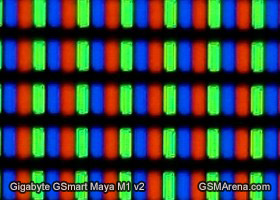Currently Gigabyte’s most advanced offering, the GSmart Maya M1 v2 is a refresh of the dual-SIM GSmart Maya M1 smartphone released in April.

The smartphone marks Gigabytes first entry into the quad-core game, featuring a four Cortex-A7 cores clocked at 1.2GHZ alongside PowerVR SGX544 GPU on an MTK 6589 chipset. Connectivity-wise, you have quad-band GSM and dual-band 3G connectivity for either SIM (although only one of them can connect to 3G at a time), WiFi b/g/n, Bluetooth 3.0, and GPS with A-GPS support.
Pros
- Solid build quality
- Relatively stock Android experience
- Display is good for its class
- Good battery performance
- microSD card slot
Cons
- Sluggish UI
- Only 2.6GB of user-available memory
- Neither SIM card is hot-swappable
- Oddly placed power/lock button
Design
The retail box the GSmart Maya M1 v2 comes in is nothing spectacular, and inside you’ll find the standard USB cable, headset, and A/C adapter configuration. The Maya has a conventional design, but the construction is solid and lends itself well to in-hand feel.




The standard retail package.
On the front you have an entirely glass panel, with an earpiece and camera located above the display, and capacitive home, back, and contextual menu buttons located below. The display is quite prone to fingerprint smudges and not being oleophobic cleaning it takes some effort.



The display is quite prone to fingerprints.
The sides of the device are bare save for a volume rocker on the left.



The sides of the device are mostly bare
The top is where all the action is, with the 3.5mm audio jack, power/lock button, and USB port sitting there. The central position of the power button is an odd choice, and makes it hard to reach. At the bottom you’ll find the single microphone pinhole and a small groove for removing the back panel.




You’ll find the two connectivity ports on top
On the back you get the 8MP camera lens with dual-LED flash and a speakerphone grille. Underneath the back panel you’ll find both SIM slots blocked off by the 1700 mAh battery (meaning they’re not hot-swappable), next to the microSD card slot (which is). The back panel itself is made out of a thick matte plastic which is virtually impervious to fingerprints. Kudos to Gigabyte for making such a snugly-fitting panel as well.



The back panel is well made and fits snugly
Display
The display of the Maya M1 v2 is the same as its predecessor, namely a 4.5″ IPS LCD unit of 540 x 960 pixels. Although we would have liked to see a resolution of at least 720p (which is more or less a minimum for midrangers these days), the display has great colors, despite minimal aberration when viewed from an angle.

The display has good colors and decent viewing angles.
We also snapped a microscopic image of the display matrix on the GSmart Maya M1 v2.

The display matrix up close.
User interface
The Gigabyte Maya M1 v2 runs Android 4.2.1 Jelly Bean in what is largely a stock Android experience. While in theory the quad-core CPU and 1 GB of RAM should be more than capable of running the interface without issue, there is a fair amount lag when performing many day-to-day operations.
If you’re coming from a entry-level smartphone, the device will certainly offer a generous upgrade in performance, but just can’t run with the big boys in regards to the smoothness of its OS. Then again, the Maya M1 v2 is priced closer to the former than the latter so this is actually not a bad showing.
The lockscreen and homescreen panes are basically stock Android, offering the same features you’d find on AOSP versions of Google’s OS. The same applies in large part to the Gallery and Music Player.




The lockscreen, homescreen, Music Player, and Gallery.
The notification area features the expandable notifications which were introduced with Jelly Bean, as well as a shortcut to menu that can quickly toggle various connectivity settings.


The notification area features quick toggles.
The 8MP camera features a special Multi-angle View mode that allows you to rotate around a stationary object and take up to 10 shots. While this does not achieve a 3D image or anything related, it stitches the images together to form a series you can then scrub through in the gallery.


The camera interface
Finally, the Maya M1 v2 features a dual-SIM manager, accessible from the Settings menu. From there you can select which SIM to use for voice calls, video calls, messaging, or data, as well as bind some of your contacts to specific SIM cards.




The SIM card manager from within the Settings menu.
Conclusion
Although not yet available in all markets, the Gigabyte GSmart Maya M1 v2 retails for right around €215, which is a compelling offering in the lower midrange market segment. And it should make a name for itself, as few devices in with that pricetag can boast a quad-core processor alongside the powerful PowerVR SGX544 graphics processor.
But while those specs are certainly appealing on paper, the real-life performance that the Maya v2 delivers is not without its share of hiccups. After all, a manufacturer like Gigabyte isn’t as experienced as some of the larger manufacturers at ironing out Android bugs, but software optimizations could always be delivered with future updates.
Source : blog[dot]gsmarena[dot]com


































































